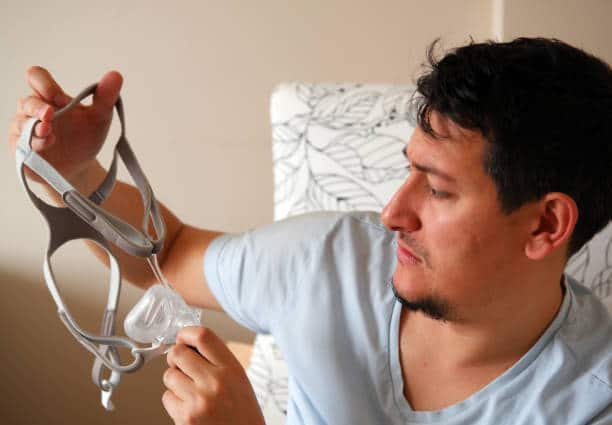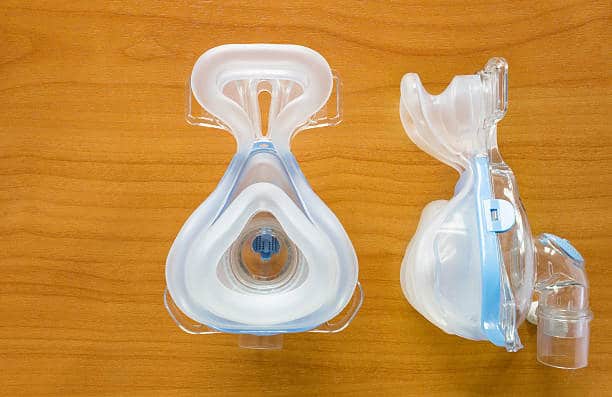Sleep apnea, which affects millions of people worldwide, can be treated with CPAP therapy. But it can be hard for many side sleepers to find the right CPAP mask. Traditional full-face masks can be uncomfortable and hard to breathe when sleeping on your side, and nasal masks can leak.
This article discusses some of the best CPAP masks for side sleepers. These masks are made to be as comfortable and stable as possible while you sleep. You can find a mask that fits your needs whether you sleep on your back, stomach, or side.
How Does a CPAP Mask Work?

CPAP masks are used to treat sleep apnea. CPAP stands for Continuous Positive Airway Pressure. A disorder known as sleep apnea occurs when a person’s airway becomes partially or totally obstructed while sleeping, causing them to stop breathing. This can happen either temporarily or permanently.
CPAP masks are worn over the nose or the nose and mouth. They are connected to a machine that blows a steady air stream into the airway. This pushed-in air helps keep the airway open and keeps breathing from stopping. CPAP therapy is thought to be one of the best ways to treat sleep apnea, and people who use it can have a much better quality of life.
Who May Use a CPAP Mask?
People with sleep apnea are most likely to use CPAP masks. Sleep apnea is when a person’s airway becomes partially or completely blocked during sleep, making breathing hard. A CPAP mask is used in CPAP therapy, which is thought to be one of the best ways to treat sleep apnea.
People diagnosed with hypopnea, snoring, or Cheyne-Stokes breathing may also use CPAP masks. People with a recent respiratory illness or surgery that makes breathing hard to breathe or who have long-term lung disease may also be given a CPAP mask.
Types of CPAP Masks for Side Sleepers
Several types of CPAP masks are designed specifically for side sleepers. These include:
Nasal Pillow Mask: These masks are designed to fit directly into the nostrils and are held in place by a CPAP headgear. They are lightweight and minimalistic, making them a popular choice for side sleepers.
Nasal CPAP Masks: These masks cover the nose only and are held in place by a headgear. They are a good option for side sleepers who prefer more coverage than nasal pillow masks.
Full Face Masks: These masks cover the nose and mouth and are held in place by a headgear. They are designed to accommodate side sleepers with a contoured design that conforms to the shape of the face, reducing the risk of leaks.
Hybrid Masks: These masks combine nasal and full-face masks; they have a nasal pillow mask that sits under the nose and a full-face cushion that sits over the mouth.
Oral Masks: These masks cover the mouth only and are held in place by a headgear. They are designed for side sleepers whose mouths breathe during the night.
Each type of mask has its unique benefits, and side sleepers should consider their individual preferences and needs when choosing a mask. It’s also worth noting that it is always recommended to consult a healthcare provider or sleep professional to determine the best mask for you.
The Importance of Proper Mask Fit for Side Sleepers
The mask must fit properly for CPAP therapy to work best and be most comfortable for side sleepers. A mask that doesn’t fit right can cause leaks, pain, and even skin irritation. A mask that fits well will make a tight seal and let less air out so that the person can breathe in the pressurized air they need to treat their obstructive sleep apnea.
Also, a mask made for side sleepers will usually be shaped to fit the shape of the face. This makes it less likely that the mask will leak and keeps it in place all night. This is especially important for people who sleep on their sides because they move around a lot while they sleep. A mask that stays in place will help keep their therapy from being interrupted.
Also Read: How To Avoid Water and Moisture in Your CPAP Tubing and Mask
Features of an Ideal CPAP Mask

If you sleep on your side, the best mask for you should have the following:
- Contoured design: This will help the mask stay in place even if the sleeper moves around a lot.
- Decent headgear: A piece of headgear that holds the mask in place and k eeps it from moving or slipping during the night.
- Adjustable straps: The mask should have straps that can be adjusted to fit perfectly. This will help make sure that the mask seals well.
- Materials that are light and let air in: The mask should be thin and made of materials that let air through so that it doesn’t make you feel uncomfortable or irritate your skin.
- Minimalistic design: The risk of feeling uncomfortable or claustrophobic will go down if the mask is simple and only covers the parts of the face that need to be covered.
- Low noise level: A mask that makes little noise when it works. This will help keep the sleeper’s partner from being disturbed.
- Simple to clean: A mask that is easy to clean will make you less likely to get sick and last longer.
- Compatible with different kinds of CPAP machines: The mask should work with different kinds of CPAP machines. This way, the sleeper can use the one they like best.
- Soft and cozy: The mask should be made out of soft, comfortable materials. This will make it less likely to hurt or irritate your skin.
- Versatile: A mask used in different sleeping positions will help ensure that the person can change positions during the night without stopping therapy.
Conclusion
People who have sleep apnea and like to sleep on their side need to find the best CPAP mask for side sleepers. A mask that fits right will give you the most comfort and stability so that your CPAP therapy works well and doesn’t stop.
This article talked about the different kinds of masks, such as nasal pillow masks, nasal masks, full-face masks, hybrid masks, and oral masks, as well as the benefits of each one. When choosing a mask, think about what you like and need, and be bold and try different types or brands until you find the one that works best for you. With the right mask, people on their sides can get a better night’s sleep and live a better life.
To enhance your CPAP experience, consider exploring a range of accessories that can add comfort and convenience to your therapy. Resway offers various options that complement your CPAP setup, ensuring a more comfortable and effective treatment.
Frequently Asked Questions
Are all CPAP Masks The Same?
No, not all CPAP masks are the same. Different types of CPAP masks are available, each with unique features and designs.
How Tight Should Your CPAP Mask Be?
CPAP masks should be tight enough to form a secure seal but not so tight that they cause discomfort or skin irritation. The headgear straps should be adjusted to create a snug fit around the face and head, but not so tight that they leave marks on the skin or cause headaches.
How Much Do CPAP Masks Cost?
A basic nasal pillow or nasal mask can cost around $50 to $100, while a full-face mask can cost anywhere from $100 to $150 or more. The hybrid and oral masks are in the same price range as the nasal pillows and nasal masks.




